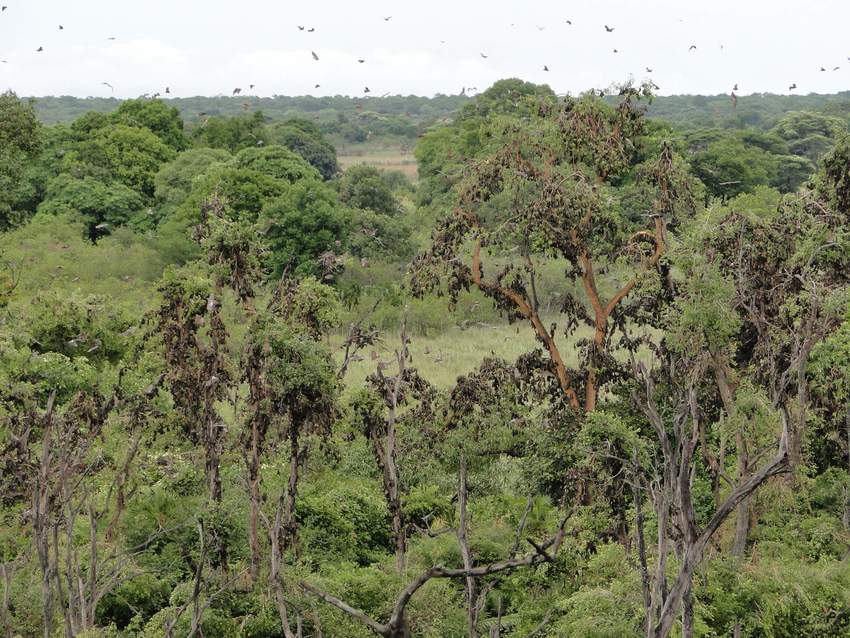
This old bull elephant is nicknamed ‘Old Kasanka’ and is instantly recognisable by his one large tusk and other shorter, broken tusk. Image credit: Kasanka Trust.
It’s relatively small, it doesn’t have the Big 5 and you may not even have heard of it. So why are we so passionate about supporting conservation projects in and around Zambia’s Kasanka National Park? We asked Richard Peel, General Manager of our local partner, Kasanka Trust, to explain why this little green corner of Africa is so important…
INTERVIEW BY WILLIAM GRAY
Bats are in the news for the worst possible reason right now… why should we still love them?
Bats are important for our environment as vectors for seed dispersal, pollination and insect control. When they gather in huge numbers as they do in Kasanka they can have a profound effect on the landscape. The impact of the bat migration in Kasanka has not been studied, but it is safe to assume that the environment in Kasanka would be quite different if the bats were to disappear. We’re doing our best to dispel the negative myths and legends surrounding bats and assuring potential visitors that there is no risk of catching diseases like COVID-19 while viewing the bat migration.

One of ten million Straw-coloured Fruit Bat which migrate to Kasanka every year. Image credit: Kasanka Trust.
How have you seen the national park change since it was created?
That’s difficult for me to say as I had only visited Kasanka a few times before I started volunteering for the Trust in 2017. Since being appointed General Manager I have noticed a marked decline in poaching intensity and a corresponding increase in mammal populations.
What are the most rewarding and the most challenging aspects of managing Kasanka?
The most rewarding aspect of managing Kasanka is looking back on the short time that I have been here and taking stock of the progress that we have made. After four consecutive years of population decline between 2014 and 2017, mammal numbers are increasing steadily, and poaching has been reduced. Our relations with surrounding communities are improving rapidly, and our park infrastructure and management capacity are poised to improve considerably over the next few years. The most challenging aspect of the job is knowing that it is never finished. Every day greets you with a new challenge, whether it is a proposed new dam for irrigation, a wind farm within the bats’ foraging area, or prospectors searching for gold, copper and manganese in the park’s catchment area. Conservation is an endless battle against the odds.
What is your greatest fear and your greatest hope for Kasanka?
My greatest fear is that the landscape surrounding Kasanka will be opened up by commercial developers for agriculture and mining, and that the ecological integrity of the park will be destroyed by deforestation, water abstraction and pollution. All the hard work the Trust and its partners have put in over the years could be undone by events that are beyond our control. But the Kasanka Trust, thanks to the outstanding support of WLT amongst other partners, has formulated a plan to secure the surrounding landscape and simultaneously empower local communities through the establishment of Community Forest Management Areas. If we can secure the forests and rivers upstream of the park in collaboration with local communities, we will ensure a bright and healthy future for the park and the people that depend on it.
If you were writing a news release about Kasanka 10 years from now, what would be your dream headline?
Large predator populations fully restored in Kasanka National Park.

A view of Zambia’s little green gem, Kasanka. The trees in the image are fully laden with roosting Straw-coloured Fruit Bats. Image credit: Frank Willems.
About Richard Peel
I am Zimbabwean born but moved to Zambia in 2004 after my parents lost their farm to the land invasions in 2002. I finished my schooling in Zimbabwe and went straight to university in South Africa right up until I finished my PhD in Ichthyology and Fisheries Science in 2016. After finishing our PhDs my partner Geraldine and I moved back to Zambia from our field site in north-eastern Namibia. Several months of fruitless job searching went by before we decided to volunteer our services to the Kasanka Trust. It was the best way of getting a foot in the door.
We started in February 2017, volunteering in Lavushi Manada National Park which was managed by the Kasanka Trust at the time. The Trust was going through a challenging period and after six months in Lavushi Manda, in August 2017, Geraldine and I moved to Kasanka to help the team here. Later that year the Trust decided to withdraw from Lavushi Manda as it could no longer afford to sustain operations there. I was asked to be General Manager of Kasanka Trust in December 2017.

